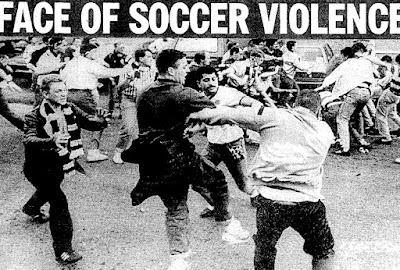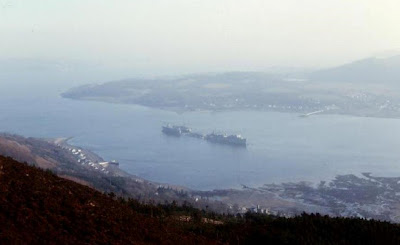After serving two years on the aircraft carrier USS Kitty Hawk in 1970-1971 during the Vietnam War, I was separated from the Navy. I attended Penn State and majored in journalism, but left as I could afford to live on the G.I. Bill alone.
I took a civilian DoD clerk job at the Defense Personnel Support Center in South Philadelphia, known locally as the "Quartermaster," but I was bored with the job, and not seeing an immediate future as a writer, I decided to re-up and go back into the Navy in 1974.
Did I mention alcohol was involved?
Having made a WESTPAC cruise to Southeast Asia aboard the Kitty Hawk, I had hoped to sail to the Med on another aircraft carrier. But my orders sent me to the Navy tugboat USS Saugus (YTB-780), which was assigned to the U.S. nuclear submarine base at Holy Loch, Scotland.
I went from serving on one of the largest warships in the U.S. Navy to one of the smallest boats.
Although I regretted going back into the Navy, and I was not too thrilled with the Scottish winter, I liked the Scottish people, especially the Scottish lasses. Scotland was a peaceful place in those days, with low crime with little violence compared to Philadelphia and other American cities.
But there were occasional incidents.
A year before I arrived, in October 1973, the newspapers across the world reported that an angry mob of Black American sailors from Holy Loch went on a rampage in Dunoon, the small Scottish town near the Holy Loch base.
According to newspaper accounts, the Black sailors broke store windows, beat up locals and brandished knives. I spoke to a sailor who was there, and he told me that the story was blown way out of proportion. The Scots were just not used to public street fights, he explained.
Unless it involved soccer - or football, as they call it.
Groups of loud, drunk and violent Scottish football fans supported their team by bashing the other team’s fans. They were, and are, known as football hooligans.
I recall after one contentious game, a group of hooligans, having mixed it up with the opposing team’s fans, visited a Chinese restaurant in Glasgow.
I was walking down the street that night towards my flat when a pile of screaming, brawling hooligans and Chinese waiters burst out of the restaurant’s door and began fighting in the street.
As an aspiring reporter and crime writer, I stood across the street from the battle and watched. There appeared to be more hooligans than waiters, and the Scots were bigger men, but the Chinese men gave as good as they got.
One waiter, like Bruce Lee in a karate movie, squared off against a big, drunk Scot. He launched into a short run and then leaped into the air and delivered a solid kick to the Scot’s chest.
It looked good, but unlike the karate movies, the kick hardly moved the hooligan. The hooligan swung a wild roundhouse that laid out the would-be-Bruce Lee.
The Scottish police arrived, and they broke up the fight by beating down both the hooligans and the waiters with their clubs. British police didn’t carry guns like American cops, but they could fight.
As the combatants were rounded up and arrested, one of the cops came over to me and asked what I was doing. Just watching, I replied. I showed my U.S. Navy ID card and the cop, who sported a black eye and torn shirt, told me to move on.
I moved on.
Sometime later, a Black sailor I knew, an affable young guy, asked me what a “nig-nog” was.
“The Scottish equivalent to the N-word,” I told him.
“I thought so,” he said. “I didn’t know what it was, but I knew it wasn’t a complement.”
He told me how he was at a train station when a group of drunken football hooligans began calling him a nig-nog from across the platform. He had been drinking a bottle of soda, and he hurled the bottle at the hooligans.
“You know how you throw a bottle and it just smashes near a group? Well, my bottle hit one the Scottish guys right in the head."
He was promptly arrested.
In 1975, towards the end of my two-year tour, I was in a Glasgow pub with my Scottish girlfriend when I had my own encounter with football hooligans.
While we were having a drink at the bar, I noticed a group of about a dozen hooligans looking over at me, pointing towards me, and grumbling. I told the girl to go across the street and wait for me.
“Let’s go together,” she said.
“I’m from South Philly. I don’t run,” I said with a sense of bravado.
Although carrying a weapon in Scotland was a serious criminal offense, I had a small but sharp pocketknife, and my right hand went to my back pocket and held the knife.
One of the hooligans staggered over to me. I took my hand off of my knife and balled a fist. I planned to “Sunday punch” this drunk if he got aggressive.
“Are you English?” he asked.
“No. I’m an American.”
He stepped back, smiled at me, and turned towards his fellow hooligans and yelled, “He’s a fookin' Yank!”
Everyone relaxed. The hooligan told me they thought I was English, and as Scotland had just defeated England in a football match, they planned to celebrate the win by beating the hell of a Englishman.
I bought a round of drinks for the hooligans and the other patrons at the bar.
Over the years, I’ve read about and watched TV news coverage of wild hooligan violence at soccer games, which always makes me think of my days in Scotland.
Note: You can read my other sea stories, vignettes, short stories and humor pieces about my time in the U.S. Navy via the below link:
Below are photos of the USS Saugus, me on the bow of the tugboat, the Holy Loch submarine base, a newspaper account of the Dunoon riot, me in Glasgow, and the USS Kitty Hawk.










No comments:
Post a Comment